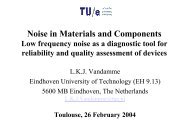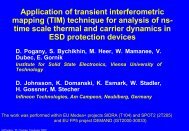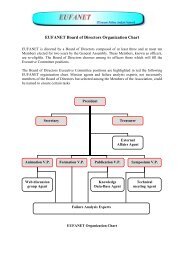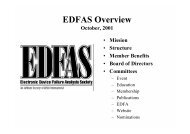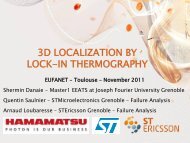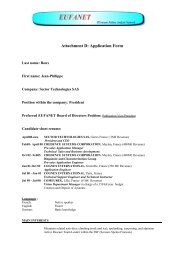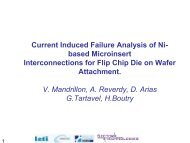Magnetic Field Imaging (SQUID and more) - eufanet
Magnetic Field Imaging (SQUID and more) - eufanet
Magnetic Field Imaging (SQUID and more) - eufanet
Create successful ePaper yourself
Turn your PDF publications into a flip-book with our unique Google optimized e-Paper software.
<strong>SQUID</strong> at Package-Level (C4 bump)IRCurrent: 125 µADistance: 450 µmIRCurrent: 8.8 µADistance: 450 µm5
<strong>SQUID</strong> at Die-Level (back-side)6
<strong>SQUID</strong> at Die-Level (front-side)OpticalCurrent DensityOverlay2.5 mm7
GMR at Die-Level (front-side)OpticalCurrent DensityOverlay8
GMR at Die-Level (wafer part using probes)Optical ImageCurrent Image30 µm100 µm0.3 µm lines with0.3 µm spacingI = 500 µA9
Performance of <strong>Magnetic</strong> Sensors10 10000 mACurrent11000mA100 100 µA10 µA 101 µA1GMRFibre/<strong>SQUID</strong> potential<strong>SQUID</strong>sample in vacuum100 0.1 nAFront Side Back Side Packaging0.1 1 10 100 1000Separation Distance (µm)S/N = 10; TC = 3 ms10
Comparison between sensors• <strong>SQUID</strong>– Most sensitive– Ideal for large working distances ≥ 100 µm– Localize defects to 3 µm• Magnetoresitive (GMR)– Less sensitive than <strong>SQUID</strong>– Good for short working distances of a few microns– Sub-micron resolution when very close• Fibre/<strong>SQUID</strong>– Less sensitive than <strong>SQUID</strong>, but can be better than GMR– Good for short working distances of a few microns– Natural high aspect ratio of tip is good for working in cavities– Sub-micron resolution when very close11
Implementation Model• Coarse scan with <strong>SQUID</strong> toisolate component• If defect is in the die, thenthin the die <strong>and</strong> fine scanwith <strong>SQUID</strong>• Locally open a cavity (laser;FIB)• Scan with magnetoresistivesensor or fibre/<strong>SQUID</strong>.12






